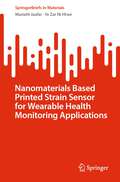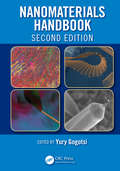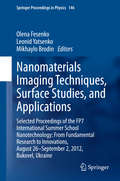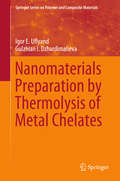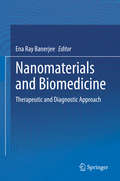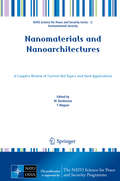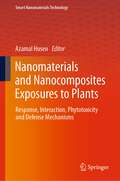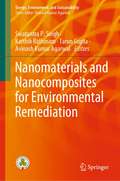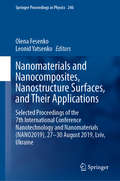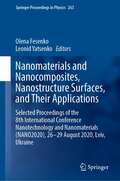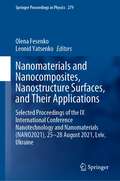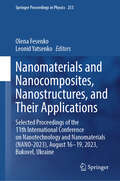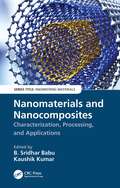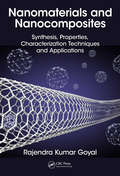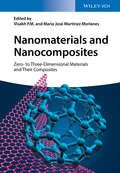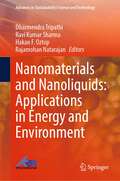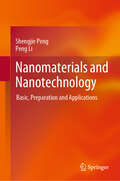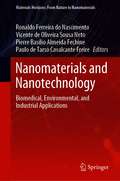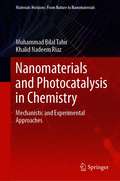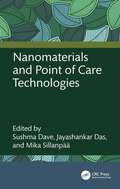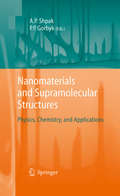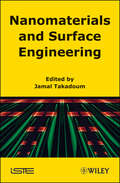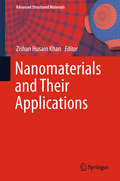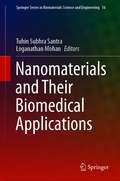- Table View
- List View
Nanomaterials Based Printed Strain Sensor for Wearable Health Monitoring Applications (SpringerBriefs in Materials)
by Mariatti Jaafar Ye Zar Ni HtweThis book reviews different types of nanomaterials-based-conductive inks used to develop printed strain sensors, printing fabrication methods, and applications such as wearable health monitoring. Printed wearable electronic devices have recently drawn a lot of attention, as shown by the increasing number of publications and commercialized devices covering various facets in emerging fields. Many researchers are working toward optimizing nanoparticle-based-conductive inks for wearable electronics. However, issues related to its stability, dispersion, and annealing temperature often limit its applications. General important information and requirements of flexible electronics for health monitoring are covered in the book chapter. The target audiences are researchers and students who are involved in the development of printed wearable electronics.
Nanomaterials Handbook (Advanced Materials and Technologies)
by Yury GogotsiThis title features 11 new chapters unique to this edition, including chapters on grain boundaries in graphene, 2D metal carbides and carbonitrides, mechanics of carbon nanotubes and nanomaterials, biomedical applications, oxidation and purification of carbon nanostructures, sintering of nanoceramics, hydrothermal processing, nanofibers, and nanomaterials safety. It offers a comprehensive approach with a focus on inorganic and carbon-based nanomaterials, including fundamentals, applications, synthesis, and characterization. This book also provides a unique angle from the nanomaterial point of view on application, synthesis, and characterization not found in any other nanomaterials book on the market.
Nanomaterials Imaging Techniques, Surface Studies, and Applications: From Fundamental Research to Innovations, August 26-September 2, 2012, Bukovel, Ukraine
by Leonid Yatsenko Mikhaylo Brodin Olena FesenkoThis book presents cutting-edge research on a wide range of nanotechnology techniques and applications. It features contributions from scientists who participated in the International Summer School "Nanotechnology: From Fundamental Research to Innovations" in Bukovel, Ukraine on August 26 - September 2, 2012 funded by the European Commission FP7 project Nanotwinning implemented by the Institute of Physics of National Academy of Sciences of Ukraine and partner institutions: University of Tartu (Estonia), European Profiles A.E. (Greece), University of Turin (Italy) and Université Pierre et Marie Curie (France). Worldwide experts present the latest results on such key topics as microscopy of nanostructures; nanocomposites; nanostructured interfaces and surfaces; nanooptics; nanoplasmonics; and enhanced vibrational spectroscopy. Imaging technique coverage ranges from atomic force microscopy and spectroscopy, multiphoton imagery, and laser diagnostics of nanomaterials and nanostructures, to resonance Raman and SERS for surface characterization, and scanning tunneling microscopy of organic molecules. The breadth of topics highlights the exciting variety of research currently being undertaken in this field and suggests new opportunities for interdisciplinary collaboration and future research.
Nanomaterials Preparation by Thermolysis of Metal Chelates (Springer Series on Polymer and Composite Materials)
by Gulzhian I. Dzhardimalieva Igor E. UflyandThe book focuses on the thermal transformations of various types of metal chelates, e.g. low molecular weight and polymeric metal chelates, coordination polymers and metal-organic frameworks. It analyzes the major advances and the problems in the preparation of metal oxide materials, mixed-oxide nanocomposites, carbon materials and polymer derived non-oxide nanocomposites by the thermolysis of different metal chelates. It also highlights the influence of the spatial and electronic structure of metal chelates on the mechanism and kinetics of their thermal transformations, and discusses important issues like conjugate thermolysis and computer modelling of the thermolysis process. This book is useful for researchers experienced in thermolysis as well as for young scientists interested in this area of science.
Nanomaterials and Biomedicine: Therapeutic and Diagnostic Approach
by Ena Ray BanerjeeThis book comprehensively reviews the history of nanotechnology, and describes the physiochemical properties of various nanoparticles and their biomedical applications. Covering the biotoxicity of nanoparticles, their bio-distribution and release kinetics, and their role in diagnosis, pre-clinical drug discovery and disease prevention, it also examines the application of nanoscaffolds in tissue engineering and as cell culture templates. Further, the book discusses several fabrication methodologies for regenerative medicine, and explores nanotechnology-based stem cell therapeutics, including stem cell transfection, stem cell delivery, and stem cell expansion for promoting tissue regeneration. Lastly, it addresses the use of DNA barcoding technology from nanosamples for the detection, identification and validation of emerging pathogens, biodiversity and ancient remnants of living specimens, and highlights various strategies for the plant-mediated synthesis of nanoparticles. Given its scope, it is a valuable reference resource for graduate students and researchers interested in understanding the diverse range of biomedical applications of nanoparticles.
Nanomaterials and Environmental Biotechnology (Nanotechnology in the Life Sciences)
by Vivek Kumar Singh Durgesh Kumar Tripathi Indu BhushanNanotechnology is considered as one of the emerging fields of science. It has applications in different biological and technological fields which deal with the science of materials at nanoscale (10-9). On the other hand, biotechnology is another field that deals with contemporary challenges. Nanobiotechnology fills the gap between these two fields. It merges physical, chemical, and biological principles in a single realm. This combination opens up new possibilities. At nanoscale dimensions, it creates precise nanocrystals and nanoshells. Integrated nanomaterials are used with modified surface layers for compatibility with living systems, improved dissolution in water, or biorecognition leading to enhanced end results in biotechnological systems. These nanoparticles can also be hybridized with additional biocompatible substances in order to amend their qualities to inculcate novel utilities. Nanobiotechnology is used in bioconjugate chemistry by coalescing up the functionality of non-organically obtained molecular components and biological molecules in order to veil the immunogenic moieties for targeted drug delivery, bioimaging and biosensing. This book blends the science of biology, medicine, bioinorganic chemistry, bioorganic chemistry, material and physical sciences, biomedical engineering, electrical, mechanical, and chemical science to present a comprehensive range of advancements. The development of nano-based materials has made for a greater understanding of their characterization, using techniques such as transmission electron microscope, FTIR, X-ray diffraction, scanning electron microscope EDX, and so on. This volume also highlights uses in environmental remediation, environmental biosensors and environmental protection. It also emphasizes the significance of nanobiotechnology to a series of medical applications viz., diagnostics, and therapeutics stem cell technology, tissue engineering enzyme engineering, drug development and delivery. In addition this book also offers a distinctive understanding of nanobiotechnology from researchers and educators and gives a comprehensive facility for future developments and current applications of nanobiotechnology.
Nanomaterials and Nanoarchitectures
by M. Bardosova T. WagnerThe current work consists of nine contributions describing recent progress in the interdisciplinary of Nanoscience, which involves physics, chemistry, engineering, biology and medicine and one essay outlining some important historical and socioeconomic factors pertaining to recent developments in nanoscale science and technology. All 10 chapters have been written by eminent experts in their respective fields. The authors employ the terms 'nanomaterials' as building blocks of a range of materials, 'nanoarchitecture' represents the design and 'nanotechnology' the means to produce a particular device or functionality. Two of the chapters are devoted to novel materials and two others focus on analyzing techniques, which can be used to enable molecular control of the film architecture. Additionally, the reader will find material devoted to photonic and hybrid plasmonic-photonic crystals as well as sections which address their applications, such as the use of plasmonic particles and nanostructures for new sensing concepts and ultrasensitive detection techniques. This work will be of interest to graduate students, researchers and practitioners alike.
Nanomaterials and Nanocomposites Exposures to Plants: Response, Interaction, Phytotoxicity and Defense Mechanisms (Smart Nanomaterials Technology)
by Azamal HusenThis book looks at the interaction between plants and nanomaterials/nanocomposites, and their effects ecology, the food chain and human health. It focuses on nanomaterials/nanocomposites phytotoxicity, which is an important precondition to promote the application of nanotechnology and to avoid the potential ecological risks. It describes the influencing factors of nanotoxicity of nanomaterials and the mechanisms of these toxic effects and defense mechanisms in plants. The chapters in this book are written by internationally renowned researchers and professionals and provides exciting and remarkable information (on the above-mentioned topics) to the scientist, researcher and student working field of plant biology, agricultural science, nanobiotechnology, plant biochemistry, plant physiology, plant biotechnology and many other interdisciplinary subjects.
Nanomaterials and Nanocomposites for Environmental Remediation (Energy, Environment, and Sustainability)
by Avinash Kumar Agarwal Tarun Gupta Swatantra P. Singh Karthik RathinamThis monograph focuses on recent development of nanomaterials and nanocomposites for pollution measurement and their control in water, air, and soil. The contents incorporate carbon-based, metal-based, and metal-organic framework based nanomaterials and nanocomposites for emerging contaminants (pharmaceuticals and personal care products) degradation, disinfection, and other traditional pollutants degradation and removal. The book also offers updated literature for researchers and academicians working in the field of environmental remediation by nanomaterials. Readers will learn about different metal and non-metal based nanoparticles for environmental remediation. It will be a useful guide for professionals, and post-graduate students involved in material science & engineering, chemical engineering and environmental nanotechnology research.^
Nanomaterials and Nanocomposites, Nanostructure Surfaces, and Their Applications: Selected Proceedings of the 7th International Conference Nanotechnology and Nanomaterials (NANO2019), 27 – 30 August 2019, Lviv, Ukraine (Springer Proceedings in Physics #246)
by Leonid Yatsenko Olena FesenkoThis book highlights some of the latest advances in nanotechnology and nanomaterials from leading researchers in Ukraine, Europe and beyond. It features contributions presented at the 7th International Science and Practice Conference Nanotechnology and Nanomaterials (NANO2019), which was held on August 27–30, 2019 at Lviv Polytechnic National University, and was jointly organized by the Institute of Physics of the National Academy of Sciences of Ukraine, University of Tartu (Estonia), University of Turin (Italy), and Pierre and Marie Curie University (France). Internationally recognized experts from a wide range of universities and research institutions share their knowledge and key findings on material properties, behavior, and synthesis. This book’s companion volume also addresses topics such as nano-optics, energy storage, and biomedical applications.
Nanomaterials and Nanocomposites, Nanostructure Surfaces, and Their Applications: Selected Proceedings of the 8th International Conference Nanotechnology and Nanomaterials (NANO2020), 26–29 August 2020, Lviv, Ukraine (Springer Proceedings in Physics #263)
by Leonid Yatsenko Olena FesenkoThis book highlights some of the latest advances in nanotechnology and nanomaterials from leading researchers in Ukraine, Europe and beyond. It features contributions presented at the 8th International Science and Practice Conference Nanotechnology and Nanomaterials (NANO2020), which was held on August 26–29, 2020 at Lviv Polytechnic National University, and was jointly organized by the Institute of Physics of the National Academy of Sciences of Ukraine, University of Tartu (Estonia), University of Turin (Italy), and Pierre and Marie Curie University (France). Internationally recognized experts from a wide range of universities and research institutions share their knowledge and key findings on material properties, behavior, and synthesis. This book’s companion volume also addresses topics such as nano-optics, energy storage, and biomedical applications.
Nanomaterials and Nanocomposites, Nanostructure Surfaces, and Their Applications: Selected Proceedings of the IX International Conference Nanotechnology and Nanomaterials (NANO2021), 25–28 August 2021, Lviv, Ukraine (Springer Proceedings in Physics #279)
by Leonid Yatsenko Olena FesenkoThis book highlights some of the latest advances in nanotechnology and nanomaterials from leading researchers in Ukraine, Europe and beyond. It features contributions presented at the 8th International Science and Practice Conference Nanotechnology and Nanomaterials (NANO2020), which was held on August 25–28, 2021 at Lviv Polytechnic National University, and was jointly organized by the Institute of Physics, the National Academy of Sciences of Ukraine, Lviv Polytechnic National University, University of Tartu (Estonia), University of Turin (Italy), Pierre and Marie Curie University (France), European Profiles S.A. (Greece), Representation of the Polish Academy of Sciences in Kyiv, University of Angers (France), Ruprecht Karl University of Heidelberg (Germany). Internationally recognized experts from a wide range of universities and research institutions share their knowledge and key findings on material properties, behavior, and synthesis. This book’s companion volume also addresses topics such as nano-optics, energy storage, and biomedical applications.
Nanomaterials and Nanocomposites, Nanostructures, and Their Applications: Selected Proceedings of the 11th International Conference on Nanotechnology and Nanomaterials (NANO-2023), August 16-19, 2023, Bukovel, Ukraine (Springer Proceedings in Physics #253)
by Leonid Yatsenko Olena FesenkoThis book highlights some of the latest advances in nanotechnology and nanomaterials from leading researchers in Ukraine, Europe and beyond. It features contributions presented at the 11th International Conference on Nanotechnologies and Nanomaterials, and was jointly organized by the Institute of Physics of the National Academy of Sciences of Ukraine, University of Tartu (Estonia), University of Turin (Italy), and Pierre and Marie Curie University (France). Internationally recognized experts from a wide range of universities and research institutions share their knowledge and key findings on material properties, behavior, synthesis and their applications. The book will be interesting for leading scientists, advanced undergraduate and graduate students in material and nanoscience. This book’s companion volume also addresses topics such as nano-optics, nanoelectronics, energy storage and nanochemistry applications.
Nanomaterials and Nanocomposites: Characterization, Processing, and Applications (Engineering Materials)
by Kaushik Kumar B. Sridhar BabuNanomaterials and Nanocomposites: Characterization, Processing, and Applications discusses the most recent research in nanomaterials and nanocomposites for a range of applications as well as modern characterization tools and techniques. It deals with nanocomposites that are dispersed with nanosized particulates and carbon nanotubes in their matrices (polymer, metal, and ceramic). In addition, the work: Describes different nanomaterials, such as metal and metal oxides, clay and POSS, carbon nanotubes, cellulose, and biobased polymers in a structured manner Examines the processing of carbon nanotube-based nanocomposites, layered double hydroxides, and cellulose nanoparticles as functional fillers and reinforcement materials Covers size effect on thermal, mechanical, optical, magnetic, and electrical properties Details machining and joining aspects of nanocomposites Discusses the development of smart nanotextiles (intelligent textiles), self-cleaning glass, sensors, actuators, ferrofluids, and wear-resistant nanocoatings. This book enables an efficient comparison of properties and capabilities of these advanced materials, making it relevant for materials scientists and chemical engineers conducting academic research and industrial R&D into nanomaterial processing and applications.
Nanomaterials and Nanocomposites: Synthesis, Properties, Characterization Techniques, and Applications
by Rajendra Kumar GoyalThe main aims of this book are to summarize the fundamentals, synthesis methods, properties and applications of nanomaterials, so as to provide readers with a systematic knowledge on nanomaterials. In addition, the book covers most commonly used characterization tools pertaining to nanomaterials. Further, it deals with relevant aspects of nanocomposites which contains dispersion of nano-sized particulates, and carbon nanotubes (CNTs) in the matrices (polymer, metal and ceramic). It also discusses development of smart nano textiles (intelligent textiles), self-cleaning glass, sensors, actuators, ferro-fluids, and wear resistant nano coatings. Aimed at senior undergraduate and graduate students, the key features on this book include: Top-down and bottom-up approaches for the synthesis of nanomaterials included Illustrates sample preparation and basic principle of characterization tools for nanomaterials Explains calculation of ratios of surface area to volume and surface atoms to bulk atoms Reviews synthesis, properties and applications of carbon nanotubes and magnetic nanomaterials Discusses size effect on thermal, mechanical, optical, magnetic and electrical properties
Nanomaterials and Nanocomposites: Zero- to Three-Dimensional Materials and Their Composites
by María José Morlanes Visakh P. M.Nanomaterials are defined as materials in which at least one length dimension is below 100 nanometers. In this size regime, these materials exhibit particular - and tunable - optical, electrical or mechanical properties that are not present at the macro-scale. This opens up the possibility for a plethora of applications at the interface of materials, chemistry, physics and biology, many of which have already entered the commercial realm. When nanomaterials are blended with other materials not necessarily in the nanometer regime, the resulting nanocomposites can exhibit dramatically different properties than the bulk material alone, leading to an enhanced performance in terms of, for example, increased thermal and mechanical stability. This book presents the synthesis, characterization and applications of nanomaterials and nanocomposites, covering zero-dimensional, elemental nanoparticles, one-dimensional materials such as nanorods and nanowhiskers, two-dimensional materials such as graphene and boron nitride as well as three-dimensional materials such as fullerenes, polyhedral oligomers and zeolites, complemented by bio-based nanomaterials, e.g., cellulose, chitin, starch and proteins. Introductory chapters on the state-of-the-art of nanomaterial research and the chemistry and physics in nanoscience and nanotechnology round off the book.
Nanomaterials and Nanoliquids: Applications in Energy and Environment (Advances in Sustainability Science and Technology)
by Dharmendra Tripathi Ravi Kumar Sharma Rajamohan Natarajan Hakan F. OztopThis book discusses recent work on the use of nanoparticles in energy and environment-related work. This book presents experimental, numerical, analytical, and theoretical work on the use of nanomaterials in energy and environment. This book helps to highlight cutting-edge research and is a ready reference for the researchers working in this arena of academia and industries. This book provides insights related to various forms of nanotechnological applications in green buildings, environmental and electrochemical, solar distillation systems, green energy, storage tank of the SWH system, solar concentrator system's receiver, and CFD simulations of various aspects of nanofluids/hybrid nanofluids, which are particularly useful, valuable for the betterment of society.
Nanomaterials and Nanotechnology: Basic, Preparation and Applications
by Peng Li Shengjie PengThis book first systematically introduces the development history, research content, and development trend of nanomaterials and then describes the preparation methods, characterization methods, physical and chemical properties, and mechanical properties of nanomaterials, so that students can have an overall understanding and understanding of nanomaterials. On this basis, the application of nanomaterials and carbon nanomaterials which are widely studied at present is taught. Finally, the latest research progress of nanomaterials is introduced. The book lists some practical examples as far as possible to make students easy to understand and master.
Nanomaterials and Nanotechnology: Biomedical, Environmental, and Industrial Applications (Materials Horizons: From Nature to Nanomaterials)
by Ronaldo Ferreira do Nascimento Vicente de Oliveira Sousa Neto Pierre Basílio Almeida Fechine Paulo de Tarso Cavalcante FreireThis book provides a complete overview of a wide range of nanomaterials from their synthesis and characterization to current and potential applications with special focus on the use of such nano-based products as functional agents in biomedical, environmental and industrial applications. It addresses the intrinsic relationship between aspects involving the synthesis of nanocompounds, their bio-physico-chemical properties and their interactions occurring in biomedical, environmental and industrial matrix. This book is of interest to engineers, academics and research scholars working in these fields.
Nanomaterials and Photocatalysis in Chemistry: Mechanistic and Experimental Approaches (Materials Horizons: From Nature to Nanomaterials)
by Muhammad Bilal Tahir Khalid Nadeem RiazThis book demonstrates the basic and fundamental aspects of nanotechnology and potential application as a photocatalysis in multiple application especially in environment and energy harvesting. This book also contains methods of preparation and characterization of unique nanostructured photocatalysts, and details about their catalytic action. The book consists of seven chapters, including the principles and fundamentals of heterogeneous photocatalysis; the mechanisms and dynamics of surface photocatalysis; research on pure and composites based materials with unique nanostructures; the latest developments and advances in exploiting photocatalyst alternatives to WO3; and photocatalytic materials for applications other than the traditional degradation of pollutants, such as carbon dioxide reduction, water oxidation, a complete spectrum of selective organic transformations and water splitting by photocatalytic reduction. This book will appeal to a wide readership of the academic and industrial researchers and it can also be used in the classroom for undergraduate and graduate students focusing on heterogeneous photocatalysis, sustainable chemistry, energy conversion and storage, nanotechnology, chemical engineering, environmental protection, optoelectronics, sensors, and surface and interface science.
Nanomaterials and Point of Care Technologies
by Sushma Dave Jayashankar Das Sillanpää MikaPoint of care (POC) diagnostic devices are predominantly used for the diagnosis and monitoring of diseases. To make these technologies scalable for manufacturing, user-friendly, inexpensive, sensitive, and rapid, a combination of such devices with nanomaterials is required. This book deals with new emerging fields such as POC technologies and advanced nanotheranostics using nanomaterials and their technologies and applications in diagnosis. In this book, current advances for the application of nanomaterials such as carbon nanotubes, graphene, and magnetic nanoparticles in POC devices and future directions are reviewed.This book: Presents a comprehensive account of needs and challenges of POC diagnostics Describes the fundamentals of rationale of nanomaterials as remarkable building blocks for biosensing Discusses development of critical diagnosis in POC systems Deals with the advantages of nanomaterial-based sensing strategies Illustrates the challenges and breakthroughs of technologies for cost-efficient biosensing platform The book is aimed at researchers and professionals in nanotechnology and biomedical engineering.
Nanomaterials and Supramolecular Structures
by Petr Petrovych Gorbyk Anatoliy Petrovych ShpakThe text features experimental investigations which use a variety of modern methods and theoretical modeling of surface structures and physicochemical processes which occur at solid surfaces. Nanomaterials and Supramolecular Structures: Physics, Chemistry, and Applications is intended for specialists experienced in the fields of Nanochemistry, Nanophysics, Surface Chemistry (and Physics), synthesis of new nanostructural functional materials and their practical applications. It will also prove useful to students, post-graduates, researchers, and lecturers.
Nanomaterials and Surface Engineering (Wiley-iste Ser.)
by Jamal TakadoumThis book covers a wide range of topics that address the main areas of interest to scientists, engineers, and students concerned with the synthesis, characterization and applications of nanomaterials. Development techniques, properties, and examples of industrial applications are all widely represented as they apply to various nanostructured materials including nanocomposites and multilayered nanometric coatings. It is recommended to anyone working in the field of nanomaterials, especially in connection with the functionalization and engineering of surfaces.
Nanomaterials and Their Applications (Advanced Structured Materials #84)
by Zishan Husain KhanThis book focuses on the latest advances in the field of nanomaterials and their applications, and provides a comprehensive overview of the state-of-the-art of research in this rapidly developing field. The book comprises chapters exploring various aspects of nanomaterials. Given the depth and breadth of coverage, the book offers a valuable guide for researchers and students working in the area of nanomaterials.
Nanomaterials and Their Biomedical Applications (Springer Series in Biomaterials Science and Engineering #16)
by Tuhin Subhra Santra Loganathan MohanThis book highlights the evolution of, and novel challenges currently facing, nanomaterials science, nanoengineering, and nanotechnology, and their applications and development in the biological and biomedical fields. It details different nanoscale and nanostructured materials syntheses, processing, characterization, and applications, and considers improvements that can be made in nanostructured materials with their different biomedical applications. The book also briefly covers the state of the art of different nanomaterials design, synthesis, fabrication and their potential biomedical applications. It will be particularly useful for reading and research purposes, especially for science and engineering students, academics, and industrial researchers.
